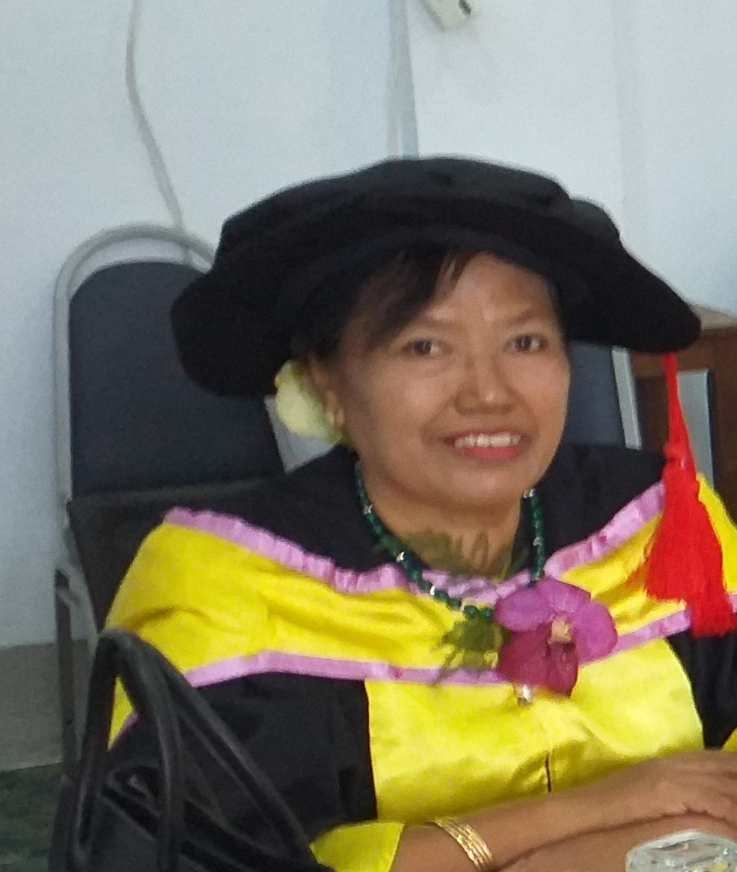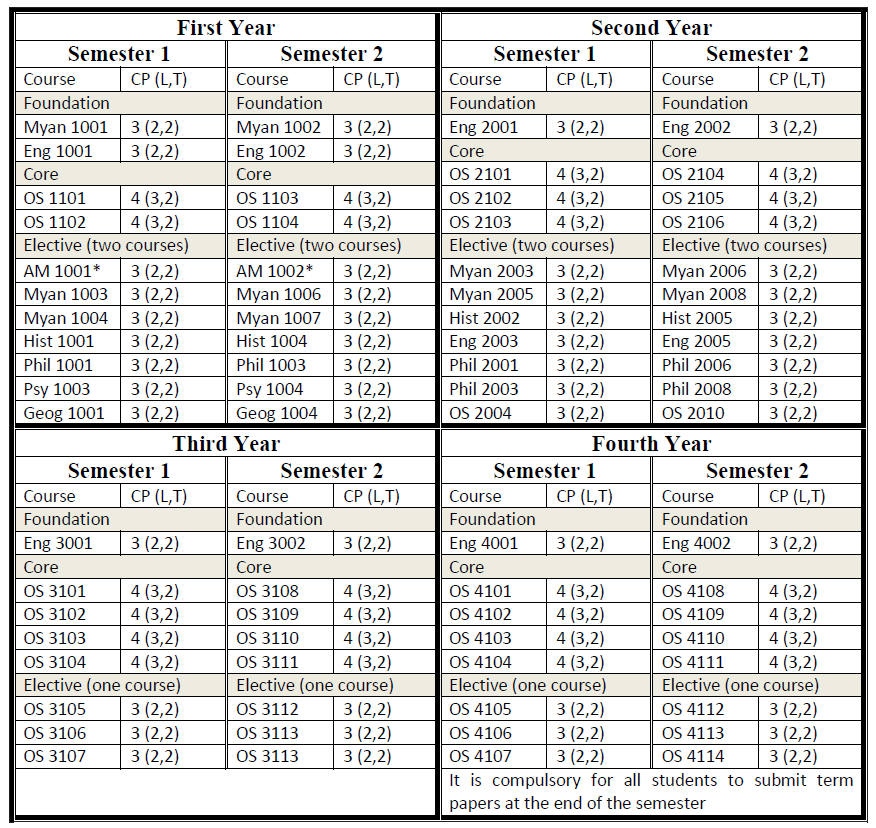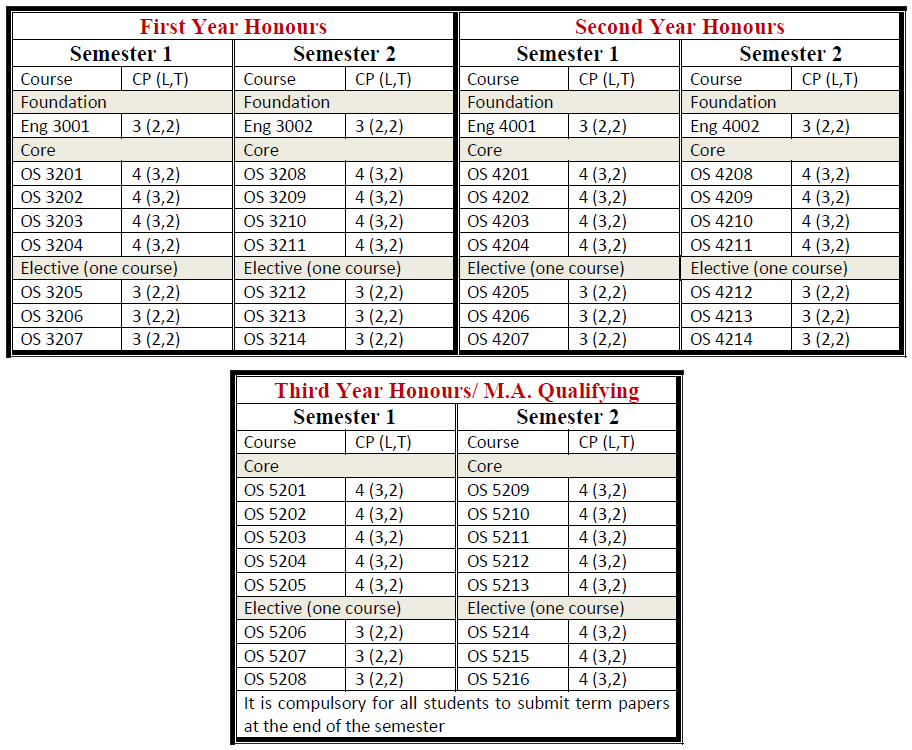
Dr. Tin San Aye
ဒေါက်တာတင်စန်းအေး
Position : Professor (Head)
Degree : BA, BA (Hons;), M.A, Ph.D
Oriental Studies
Position : Professor Department of Oriental Studies
Degree : B.A, M.A, Ph.DDr.New New Win ဒေါက်တာဒေါ်နွယ်နွယ်ဝင်း
Teacher list
| Sr.No | Department | Name | Position | Education | Thesis Title | Field Of Specialization | Current Research Project | Email/Gmail |
| 1 | Oriental Studies | Dr.Tin San Aye | Professor (Head) | Ph.D | Comparative Studies of Jātakamālā with Jātakas stories in Pāli Literature | Literature | “မြန်မာမင်းအဆက်ဆက်ကျင့်သုံးခဲ့သော ပရိတ်တော်များကိုလေ့လာနေပါသည်” | [email protected] |
| 2 | Oriental Studies | Dr.Nwe Nwe Win | Professor | Ph.D | The Lives and Abilities of Two Women Bearing the name Mallikā During The Life Time of the Buddha | Literature | [email protected] | |
| 3 | Oriental Studies | U Zin Min Oo | Associate Professor | MA | THERAVADA BHUUDISM IN SRIKSETRA | Literature | [email protected] | |
| 4 | Oriental Studies | Dr. Thin Thin Mu | Lecturer | Ph.D | A Comparative Study of the Verses of the Lokanīti and their Sanskrit Sources | Literature | [email protected] | |
| 5 | Oriental Studies | Daw Khin Thiri Thet Naing | Tutor | MA | The Vital Role of Moral in Leadership Cited in Mahāsupina Jātaka | Literature | [email protected] |
Programmes Offered
- B.A. / B.A. (Hons) in Oriental Studies
- M.A. and M.Res. in Oriental Studies
Curriculum
B.A. in Oriental Studies

B.A. (Honours) in Oriental Studies
Students who passed second year with GPA ≥ 4 are eligible to attend B.A. (Honours) classes for three more years. After finished successfully, they are earned B.A. (Hons) degree majoring in Oriental Studies.

M.A. in Oriental Studies

Course Descriptions
This module covers the basic principles of Pāli Grammar: Introduction to Pāli, Pāli Alphabet in Roman and Myanmar Scripts, Declension of the Nouns ending in a, ā, i, ī, and u, Seven conjugations, Tense Terminations (Present, Imperative, Optative, Past Tense (Aorist), Future Tense), Patisedha-nipāta (Prohibitive Particles), Sambandhana (Conjunctions), Pubbakālakriyā (Gerund), Icchatthakriyā (Infinitive), and Itivacana (Direct Narrations). This will provide students with the knowledge of sentence construction, translation and Pāli Piṭaka.
This module includes life of the Buddha with an introduction to the Jātakatthakathā and seven Jātakas extracted from it. Life of Buddha provides students with the knowledge of the history of Buddhism. Pāli Literature (prose) introduces the Division of Pāli Canon, the khuddakapātha and the Maṅgalasutta, the Dhammapada and three vaggas extracted from it, and the Lokanīti and 20 verses extracted from it. The Division of Pāli Canon provides students with the knowledge of Pāli Tipiṭaka. The Maṅgalasutta gives way to gain the good fortune in daily life. The Dhammapada acquaints students with the Buddha’s teaching. The Lokanīti imparts the worldly wisdom to the men dealing with educational, social, political, moral, and civic duties to be fulfilled as a household man.
This module deals with the basic principles of Pāli Grammar: Participles (Present, Past and Future), Nouns ending in consonants, Pronouns (Personal, Demonstrative, Relative, Interrogative and Indefinite), Numerals, Adjective, Causative Verb, Passive Verb, Interrogative Sentences, Absolute Construction, and Translation. This will provide studentswith the knowledge of sentence construction, translation and PaliPitaka.
The module is concerned with Division of Pāli Canon, Maṅgalasutta, Dhammapada, and Lokanīti verses. The Division of Pāli Canon provides students with the knowledge of Pāli Tipiṭaka. Maṅgalasutta gives way to gain the good fortune in daily life. Dhammapada acquaints students with the Buddha’s teaching. Lokanīti imparts the worldly wisdom to the men dealing with educational, social, political, moral, and civic duties.
This module includes the basic principles of Pāli Grammar: Sandhi, Nipāta, Possessive and Comparative Adjective, Prefix, Feminine Suffixes, Adverbs, Interjection and Vocatives, and Translation. This will enable students to be familiar with sentences construction, translation and PāliPiṭaka.
The module focuses on the extracts from the Vinaya and Dhīghanikāya Mahāvaggas. It offers knowledge of the Vinaya rules and Suttas preached by the Buddha. It also helps students to understand the conditions of Indian society in the life time of the Buddha.
The module is concerned with the extracts from Theragāthā and Therīgāthā.
This module covers the basic principles of Pāli Grammar: Desiderative verb, Denominative verb, Intensive verb, Usage of Cases (Kārakas), Compound (Samāsa), Secondary derivative (Taddhita), and Translation. This will provide students with the knowledge of sentence construction, translation and the PāliPiṭakas.
The module deals with the extracts from the SaṁyuttaNikāya which is the moral, social lessons and Law of Kamma. It also introduces students to the life of the Buddha and other lessons in the Jātakatthakathā.
This module deals with Introduction to Pāli, Ten Major Branches of Indo-European Family, The Origin of the Indo-Aryan, Indo-Iranian and Indo-Aryan, Three Indo-Aryan Periods, Etymology of Pāli, and Home of Pāli.
The module covers Buddhist Councils (First, Second, Third), the important milestones in the history of Buddhism. It introduces students to the origin of the Buddhist Councils, Venues, presidents, and number of monks, sponsors and results. It can also enable students to gain knowledge of the background history.
This module deals with Buddhist Councils (Fourth, Fifth, Sixth), the important milestones in the history of Buddhism. It enables students to gain knowledge of the origin of the Buddhist Councils, Venues, presidents, and number of monks, sponsors and results. It will also help them to read the background history.
The module is concerned with the extracts from the Khuddakapāțha and Paṇditavagga, Attavagga and Lokavagga from the Dhammapada. It introduces students to Mettasutta which is the special moral ethics, loving-kindness to practise accordingly. It also familiarizes them with the verses of the Dhammapada which instruct the moral ethics to develop the art of living.
The module focuses onthe extracts that are Cūḷamālukyaputtasutta, Cūlakammavibaṅgasutta from the Majjhima Nikāya; and Kesamuttisutta from the AṅguttaraNikāya. It is also concerned with Pañattipañha, Pabbajjapañha, Sīlakkhaṇapañha and Satilakkhaṇapañha in the Milindapañha.
This module acquaints students with the Sanskrit alphabet in Devanāgarī and Roman scripts, Vowel Sandhi rules, and declension of nouns ending in a and ā. It will also help them to understand the First, Fourth, Sixth and Tenth Conjugations, and Tense Terminations. The focus is on Sanskrit Language.
The module introduces students to a brief history of the Indo-Aryan languages and various uses of the word ”Prakrit.” It familiarizes them with the Dramatic Prakrits and Jain Prakrits, the General Character of Prakrit, the Phonetics, and the Saurasenī Extracts No. 1-4. Subject Defined also provides students with the knowledge of a brief history of the Indo-Aryan languages and the historical relationship between Sanskrit, Prakrit and Pāli.
The module deals with Pāli Conversation and Composition. It will help students to have mastery of sentence construction, and translation.
The module is concerned with History of Buddhism in Myanmar. It introduces students to a brief history of Buddhism of Thaton, Suvanabhūmi, Sarekhetra, Rakhine and Bagan.
The module covers Linguistics: general characteristics of Languages, origin of the Language, fields of Linguistics, Phonetics, Phonology, Morphology, and Syntax of Semantics.
The module deals with the extracts from the Texts: Udāna, Itivuttaka and Suttanipāta. The Udāna provides students the place and time of the utterances the Buddha had uttered which seem to be compiled in the early period of the Buddha’s Life. The Itivuttaka introduces them to the utterances of the Buddha which mean ”Thus, it is said”. It helps students to appreciate sutta which expresses the discourses and philosophical ethics the Buddha desired to share.
The module is concerned with the extracts that are Samādhipañha, Paññattipañha, Dhammasantatipañha and Vedagūpañha from the Milindapañha Text. It aims at helping students to study the problems of Buddhist philosophy bymeans of available similes in Life.
The module familiarises students with the Consonantal Sandhi, Visarga Sandhi, Declension of nouns ending in, ī, u and ū, the Future and Imperfect Tense Terminations, the Second, Third, Fifth, Seventh, Eighth and Ninth Conjugations, Translation of Sanskrit to English and that of English to Sanskrit.
The module deals with Prākrit. It introduces students to Compound Consonants, Vowels, Sandhi, Jain Mahārāstsrī, the story of Mandio the Robber the Robber, Domuha, and the Ardha-Māgadhī Udāyana.
The module focuses on History of Buddhism in Thailand, Cambodia, Laos, Indonesia, Vietnam, Sri Lanka and Tibet.
The module acquaints students with Pāḷi Literature from the Dhammapad, Suttanipāta, Theragāthā and Therīgāthā Texts.
This module covers Anāthapiṇḍikaseṭhivatthu and Cittagahapativatthu from the Dhammapadaṭṭhakatthā, Meṇḍakapañha (Sabbaññubhāvapañha and Maccupāsammuttipañha) from the Milindapañha Text, and Guttilajātakavaṇṇanā from the Jātakaṭṭhakathā.
The module deals withdeclension of Nouns ending in ṛ, Pronouns, Particles, tense termination (Perfect tense), gerund, infinitive and translation.
The module is concerned with the Rājakumāra Pāḷi Inscription and Kalyāṇī Pāḷi Inscription.
This module deals with History of Pāli Literature in Myanmar: Pinya, Innwa, Nyaungyan, Konboung.
The module offers knowledge of the Buddhist culture: the three Gems, the three Refuges, Morality, Prayer, Sending Mettā and Sharing Merits, which are the basics for all Buddhists to be understood and practised.
This module introduces Origin of Stupa and Temple, Kinds of Stupas, Parts of the Stupa, and Decorative Statues of Pagoda – Sakka, Brahmā, Manussīha, Hamsa, Nāga, Sīha, Vasundarī, Dagon-dine (Flagstaff).
The module covers Siṅgālasutta from the Dīghanikāya, Jīvakasutta and Aṅgulimālasutta from the
Majjhimanikāya, Akkhaṇasutta from the Aṅguttaranikāya and Dhajaggasutta from the Saṁyuttanikāya.
Majjhimanikāya, Akkhaṇasutta from the Aṅguttaranikāya and Dhajaggasutta from the Saṁyuttanikāya.
The module focuses on ”the righteous man” from Sujanakaṇḍa, “the evil man” from Bāladujjana and
“the friendship” from Mittakaṇḍa of the Lokanīti Text.
“the friendship” from Mittakaṇḍa of the Lokanīti Text.
This module familiarizes students with Declension of nouns ending in consonants, Aorist Tense Terminations, the Causal Verb, Passive Verb and Translation.
The module is concerned with Seven Aśokan Pillar edicts.
This module deals with Kason Festival, Wazo Festival, Thadingyut Festival, Pavāraṇā Ceremony, Initiation Ceremony, and Ordination Ceremony.
The module covers the Two Worldly guardian dhammas (Hirī and Ottappa); the Four Sublime States of mind practised by the Brahmas (Brahmavihāra); the Three Characteristics (Anicca, Dukkha, Anatta) ‒
impermanence, suffering, non-self; the Four Noble Truths (Catusaccāni); Charity (Dāna); Morality (Sīla)
and the Insight Meditation (Bhāvanā). The focus is on the most important Buddhist Philosophy.
impermanence, suffering, non-self; the Four Noble Truths (Catusaccāni); Charity (Dāna); Morality (Sīla)
and the Insight Meditation (Bhāvanā). The focus is on the most important Buddhist Philosophy.
This module introduces Buddha Image: History of Buddha Image, Buddhist Iconography, Uṇhīsasīsa,
Bhūmiphassa, Dhammacakka , Abhaya, Varada, Jhāna, Sīhāsana, and Padumāsana.
Bhūmiphassa, Dhammacakka , Abhaya, Varada, Jhāna, Sīhāsana, and Padumāsana.
The module deals with Kaccāyana (Ākyātakappa).
The module covers the extracts from Dhammapada: Appamādavagga, Bhikkhuvagga, Maggavagga and Suttanipāta: Atthakavagga, Theragāthā: and Therīgāthā.
This module deals with Hitopadeśa (Nidānavatthu, The Old Tiger and the traveller, The Deer, the Crow
and the Jackal).
and the Jackal).
The module acquaints students with Seven Aśokan Rock Edicts (I-V)
This module introduces students to Ancient Indian History (Maurya Empire).
This module introduces the History of Pāli literature in Bagan Period.
The module includes Introduction to Mahāyāna Buddhism: Hīnayāna and Mahāyāna, Causation, Karma and Non-Ego, The Buddhist Doctrine of Knowledge, Tathata, Nirvana, Trikāya (The Three Bodes of the Buddha), Amida, Bodhisattva, Enlightenment and Salvation.
This module introduces the knowledge of Painting and Sculpture in Bagan.
The module familiarizes students with Pañcasatikakkhandhaka, Sattasatikakkhandhaka from VinayaPiṭaka: Cūḷavagga.
The module deals with the extracts from the Majjhimanikāya: Pāsarāsisutta, Alagaddūpamasutta and Samyutta Nikāya: Sagāthāvagga-Nidānavaggasamyuttapāli: Kosalasamyutta-Pathamavagga, Anguttaranikāya: Atthakanipātapāli: Paññāsutta, Dutiyalokadhammasutta.
This module is concerned with Nala and Damayantī (Chapter I and II) and Hitopadeśa: The Blind Vulture and The Cat.
This module introduces the knowledge of Buddhist Philosophy: Abhidhammatthasaṅgaha.
The module covers Rāmāyana, Mahābhārata, Kāvya Literature, Drama Literature,
Nīti Literature: Pañcatantra and Hitopadeśa.
Nīti Literature: Pañcatantra and Hitopadeśa.
The module covers the Introduction to Prākrit: Classification of Prakrits, and Prakrit Literature.
This module introduces the knowledge of Further Development of Mahāyāna, Mahāyāna in Practice, and Outline of Some Important MahāyānaSūtras.
The module familiarises students with Votive Tablets in Myanmar.

